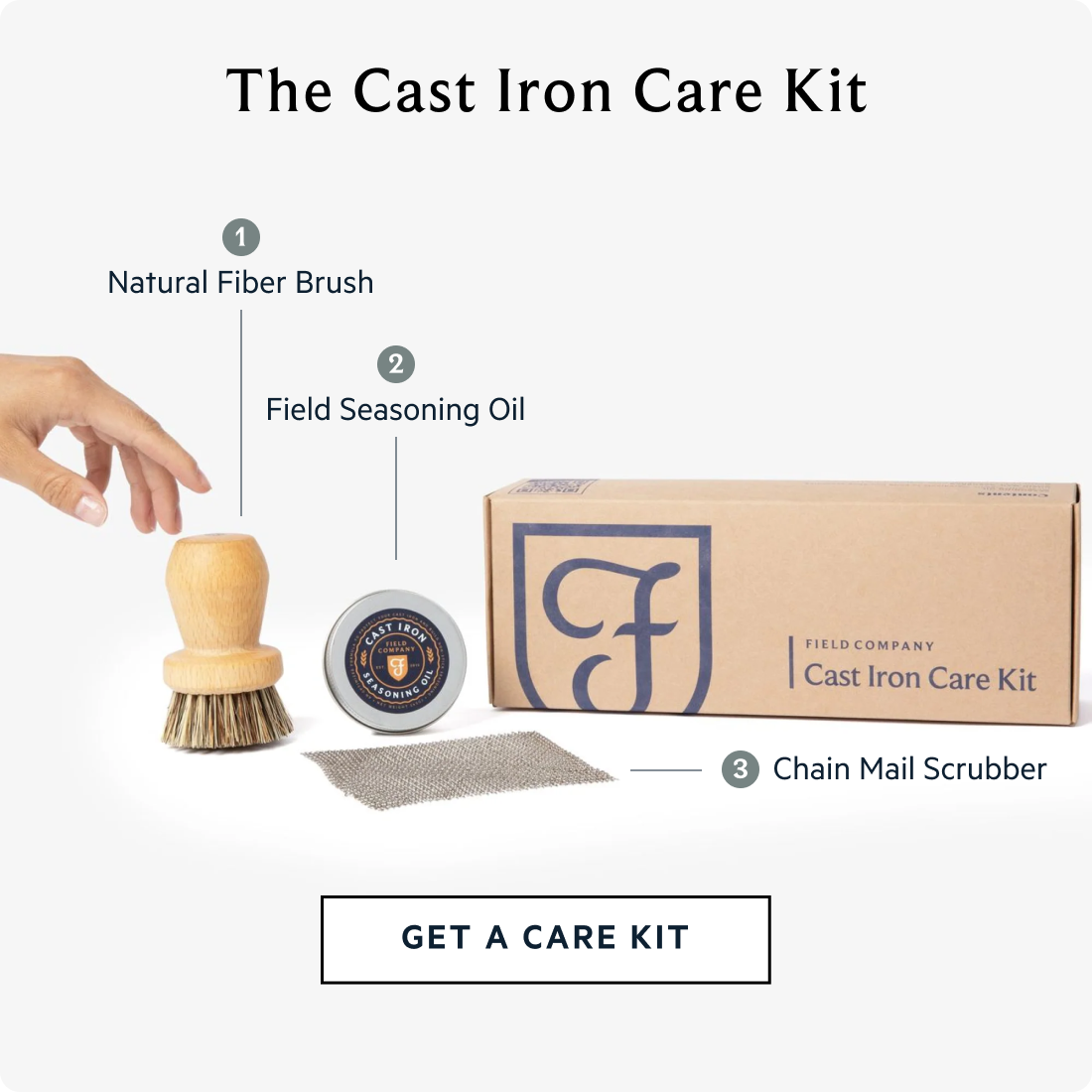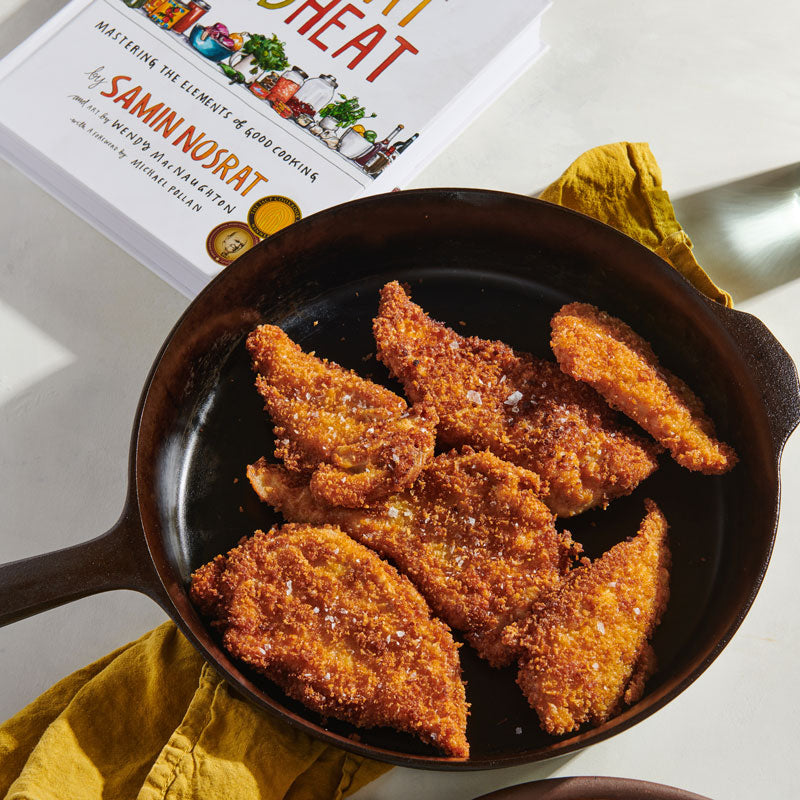Recipes
How To — Roast Chicken in Cast Iron
Mastering the art of roasting chicken in cast iron just got easier and more delicious.
Roasting a whole chicken in cast iron is one of the easiest and most rewarding ways to cook a deeply flavorful and beautifully crisp bird. Whether you’re using a cast iron skillet or a Dutch oven, this method ensures even cooking, a crispy golden-brown skin, and juicy, tender meat. Best of all, it’s a one-pan meal—just add some vegetables and let the chicken baste them as it roasts.
Using cast iron gives your chicken an even heat distribution, meaning no hot spots or uneven cooking. Plus, the natural seasoning of your skillet or Dutch oven will only improve over time. With a few simple techniques, you’ll be able to roast a restaurant-quality chicken right at home.
Skillet vs. Dutch Oven: Which Should You Use?
Both a Field cast iron skillet and a Dutch oven are great for roasting chicken, but they offer slightly different advantages:
-
Field Skillet: Provides the best skin crisping due to direct exposure to high heat. Great for a classic roast chicken with an open-air environment that promotes deep browning.
-
Dutch Oven: Offers a slightly more forgiving cook, especially for juicier meat, by trapping some moisture. Starting the chicken breast-side down can help steam the meat before flipping for crisping.
Choose whichever works best for your cooking style—or experiment with both to find your favorite!
Tips for the Best Roasted Chicken
-
Dry Brine for Better Flavor – If you have time, sprinkle kosher salt over the chicken and refrigerate for up to 24 hours. This enhances seasoning and helps dry out the skin for better crisping.
-
Use High Heat – A 450°F oven ensures golden, crispy skin while locking in juices.
-
Let it Rest – Allowing the chicken to rest after roasting keeps it juicy and prevents juices from running out when carving.
-
Experiment with Seasoning – some of our go-to's include:
- Fennel Butter Chicken over Fennel, Onions and Apples
- Za'atar Sumac Chicken over Shallots, Preserved Lemon and Chickpeas
- Gochujang Chicken over Sweet Potatoes
Our go-to method!
Once you master the method, the flavor possibilities are endless.
- SALT: Salt your chicken as far ahead of time as possible
- COAT: Coat the chicken in fat and flavorings: softened butter or herb infused butter, olive oil, or a mix of things
- ROAST: Cook it a 450º over a bed of aromatics and veggies
- FINISH: it was splash of acid
Ingredients
-
1 whole chicken (3 ½ to 4 pounds), giblets removed
-
1 tablespoon kosher salt
-
1 teaspoon freshly ground black pepper
-
3 tablespoons unsalted butter, melted
-
1 tablespoon olive oil
-
4-6 shallots, peeled and halved lengthwise (or 1 onion, cut into wedges)
-
3 medium carrots, cut into 1-inch pieces
-
12 ounces small potatoes, halved
-
3-4 sprigs of fresh herbs (rosemary, thyme, or sage)
-
2 garlic cloves, finely chopped
-
½ lemon
-
2 tablespoons chopped parsley (for serving)
Tools
Resources
The Field Method for Cast Iron Care
Instructions
Prep the Chicken: Pat the chicken dry with paper towels. Sprinkle kosher salt and black pepper all over the surface and inside the cavity. If possible, refrigerate the chicken uncovered for at least 30 minutes (or up to overnight) to promote crispier skin.
Preheat the Skillet & Oven: Arrange a rack in the center of the oven and place a No.10 cast iron skillet inside. Preheat the oven to 450°F.
Season & Arrange Ingredients: Remove the hot skillet from the oven and place the chicken, back-side down, in the middle of the pan. Drizzle melted butter over the top. Arrange the shallots, carrots, and potatoes around the chicken. Drizzle everything with olive oil and season with salt.
Roast the Chicken: Return the skillet to the oven and roast until the juices run clear and an instant-read thermometer inserted into the thickest part of the thigh reads 165°F, about 40 minutes to 1 hour.
Rest & Serve: Let the chicken rest for 10-15 minutes before carving. Squeeze fresh lemon over the top, sprinkle with parsley, and serve with the roasted vegetables.
Prep the Chicken: As with the skillet method, pat the chicken dry and season well with salt and pepper. If possible, refrigerate uncovered for at least 30 minutes to ensure crispier skin.
Preheat the Oven: Set a rack in the middle position and preheat the oven to 450°F.
Prepare the Dutch Oven & Vegetables: In a No.8 Dutch oven, toss the potatoes, carrots, onion, and garlic with 2 tablespoons of olive oil and a pinch of salt. Place the chicken on top of the vegetables, breast-side down. This helps steam the meat for extra juiciness.
Roast & Flip: Roast uncovered for 10 minutes, then carefully flip the chicken breast-side up. Continue roasting until the thickest part of the thigh reaches 165°F, about 35-45 minutes longer.
Rest & Serve: Transfer the chicken to a cutting board and let rest for at least 10 minutes. If the vegetables need more time, return the Dutch oven to the oven for a few extra minutes until tender. Carve the chicken and serve with the roasted vegetables, finishing with a squeeze of lemon and fresh parsley.
Final Thoughts
Whether you choose to roast your chicken in a cast iron skillet for maximum crispiness or a Dutch oven for extra moisture retention, both methods will result in a delicious, one-pan meal. The combination of simple ingredients, high heat, and cast iron’s even cooking ability makes for a meal that’s perfect for both weeknight dinners and special occasions
Seasoning Rating: Better
Roasting Chicken in Cast Iron is a great way to use your skillet!
Once you're done feasting we recommend cleaning things up right after serving and following the Field Method to keep your cast iron in good shape!
Seasoning Ratings:
Best—These dishes are the best options for building resilient seasoning, and surefire choices for getting tricky pans back on track.
Better—The best way to keep your skillet in great shape is to cook frequently, and cast iron-friendly dishes like these are your bread and butter.
Safe—These recipes won't strip seasoning away from your pan, but won't really add any, either.
OK—Be sure to clean up promptly. Recipes with this rating might feature acidic ingredients which can affect seasoning if not washed soon after cooking.




